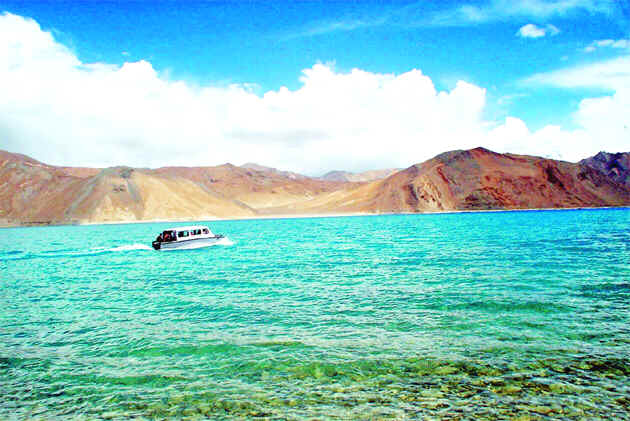Pangong Lake
Pangong Lake, also known as Pangong Tso (Tso is Ladakhi for Lake) is situated on the Changtang plateau at an altitude of 4350mts above sea level in the northeast of Leh, about 140 km from Leh city. The roughly 5 hour drive from Leh city crosses Chang La Pass, the third-highest moterable pass in the world. Spanning the border between India and China (about 40% of the lake is in India) this famous lake is one of the most spactacular lakes in Ladakh.
While travelling from China to Ladakh this route was used by Guru Nanak (To read more about his travels through the area see Nanak in J & K.) The long and narrow lake, 5-6 Km wide and over 144Km long, lies in the neighborhood of the famous Chushul Mountains. The size of the lake is best inferred from the etymology of its name Pangong which means 'extensive concavity' or a large hollowed-out area.
The lake is noted for its crystal clear blue-blackish water which keeps playing tricks on your eyes changing colours in seven distinct shades of blue, green, purple, turqoise and violet depending on the angle of your view. The shores of the lake are white with the salt deposited by the lake's brackish waters. The panarama, of the golden coloured chiseled peaks surrounding the lake, is reflected deeply into the waters. The beauty of the sight is totally mesmerizing.
Despite being a salt water lake Pangong Tso freezes over completely in the winter. A remnant from the ice age, it probably formed from the minerals the dead ice masses left as they melted scowering the mountain walls. This is the same process the rivers of the world use as the sediment they carry scrapes their beds carrying salt and other minerals from their mountainous beginnings to the worlds' seas or samudras (sa-to go, mudra-to mix.)
It is the largest brackish water Lake in Asia and an important breeding ground for migratory birds crossing the Himalayas.
As the lake is bisected by the International border between India and Tibet/(China) no boating is allowed. The Lake was formerly divided between Ladakh and Tibet as stated in the 1684 Treaty of Tingmosgang signed between the king of Ladakh—Deldan Namgyal and the Regent of Tibet.

